The Salkantay Trail is one of Peru’s most spectacular multi-day hikes. It is seen as the wilder and longer alternative to the classic 4-day Inca Trail.
As the trail grows in popularity each year, so does the number of Salkantay tour companies selling it. There are definite perks to joining an organized tour. However, experienced backpackers may prefer a more rugged experience. No permits are needed for this route which makes hiking the Salkantay a lot easier to organize.
After hiking the Salkantay trail myself, I have written this article and compiled this list of info, tips, and advice for planning your solo hike. With a little preparation, you should have no issue taking on the Salkantay Trek unguided.
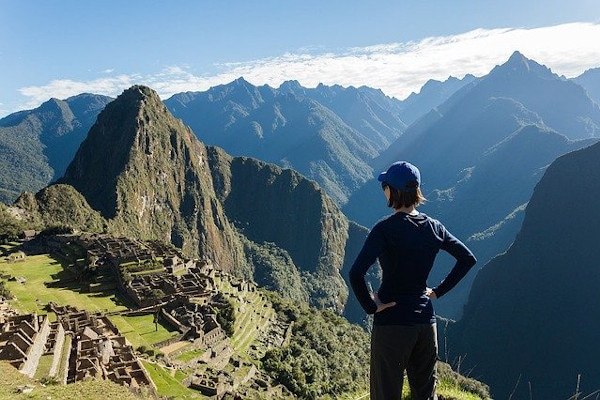
Get a Machu Picchu trek quote
Start planning your Machu Picchu hiking holiday.
A Solo Salkantay Trek - Hiking Advice for the DIY Backpacker
Can I Hike The Salkantay Trek Without A Guide?
The answer to this is 100% yes. The trail is very clear and the local people are friendly and helpful. You can easily find accommodation and food along the way. This means that, with minimal planning, you can embark on this trail without booking a tour.
You can’t throw a rock in Cusco without hitting a tour office selling the Salkantay trek. If you enquire at these offices, you may well be told that it is too remote or dangerous to hike solo. Of course! Tour operators are not about to promote their biggest seller as a DIY hike.
It will benefit you greatly to speak some conversational Spanish. Speaking some local lingo will (literally) open doors when you are trying to find accommodation, directions, or a place to eat.
Looking for a day tour? Here are my 5 favourite day tours around Cusco:
- Rainbow Mountain day trip (with meals)
- Moray and Salt Mines Quad Bike Tour
- Sacred Valley day tour
- Humantay Lake day tour
- Machu Picchu and Huayna Picchu entrance tickets
See more Cusco day trips.
Is It Safe To Do A Solo Salkantay Trek?
As far as safety goes, you will be fine walking without a group. As the trail has grown in popularity, so have the facilities around the route. You seldom go more than 3 hours without stumbling across a rest point with a snack store and toilets.
During my Salkantay trek, I met a handful of solo hikers, including solo female travelers like myself. None of these unguided hikers had any complaints. In fact, most were happy with the freedom to rise on their own schedule and set their own pace.
Also, there are multiple other people on the trail at any given time. If you get into a sticky situation, help wouldn’t be far off. Make sure you pack a first aid kit with the essentials as well as your prescribed medication.
You may also like...
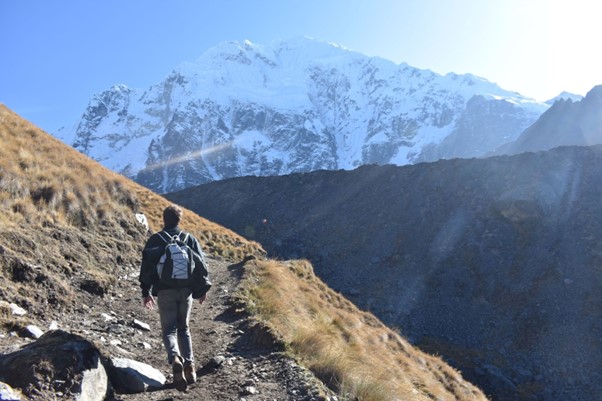
Where do I sleep on the Salkantay trek?
Imagining hauling a tent up the mountainside is what initially put me off hiking the Salkantay unguided. But in reality, you have a whole range of options for accommodation on the Salkantay Trek.
You will end each day in a set camp or small town. It is very easy to find somewhere to sleep. You can usually pay for a homestay or dorm room in the small towns on route. It is also possible to find campsites where tents, mattresses and sleeping bags are provided. Some towns have fancier options like glass domes too.
There is a variety of choices depending on your budget. You may have to hunt around a bit for a place that isn’t booked up by a tour company. On my third night hiking the Salkantay Trek, I was offered accommodation while strolling around Santa Theresa with a beer in hand. It’s really that easy to find a place to rest your head!
Cold showers and toilets are usually included in the price you pay for accommodation. If you ask around, you can sometimes find hot showers for an extra 10 soles.
I haven’t tried this option, but I doubt you could book some of these places in advance. I recommend arriving early to secure your sleeping arrangements for the night.
Where to stay? Here are 5 of my favourite accommodation options in Cusco:
- Sonesta Hotel (great 4 star hotel)
- Antigua Casona San Blas
- El Mariscal Cusco (very good value)
- Hotel Paradis (good 3 star hotel)
- Quechua Hostel Recoleta (cheap and cheerful)
See more Cusco accommodation options.
What do I do for meals when hiking the Salkantay trek unguided?
Have no fear, you do not need to plan and prepare 5 days' worth of meals for this hike. The villages and campsites along the trek have restaurants and ‘snack bars’.
You will be able to buy a plate of food or sandwich for almost every meal. Provided you are not too picky about where you eat, you can usually pay a little extra at hostels or guesthouses to include meals.
I recommend stocking up on some snacks before you hit the trail. Prices are a lot higher along the trekking route. There is an amazing variety of dried fruit and nuts cheaply available in Cusco’s markets. San Pedro Market has the biggest variety of trail-friendly food and snacks.
Kiwichi bars also make perfect lightweight trail snacks. You will see these cereal bars in every corner shop around Cusco. They sell for around 1 sole each ($0.25c!)
You can of course go hardcore-outdoorsman (or woman) and cook for yourself. In this case, you will need to have cooking gear. Here are some good examples of camping cookware and camping gas stoves you can use during your solo Salkantay Trek.
How much does it cost to hike the Salkantay Trek on your own?
It is possible to do a solo Salkantay Trek for around $175-$200 per person. This price includes food, accommodation, basic transport and Machu Picchu entrance tickets.
This price varies depending on the type of accommodation and meals.
Whether or not you hire hiking and camping equipment will also factor into the overall cost. If you are hiking as a couple or a group, you will be able to share certain costs.
Packing for your Solo Salkantay Trek - Some DIY Backpacking Tips
If you are doing a solo Salkantay trek, you will need to carry your own gear. You can find accommodation along the way, but you may want to bring a tent. This is only if you plan on camping in more remote campsite locations.
Pack light and avoid taking too many duplicate items on the packing list. For example, take only one pair of trekking trousers instead of two.
You will be able to buy meals and snacks along the way. Just to be safe, you should pack some ramen noodles, trail mix, and energy bars.
Try to keep your pack under 15kg; any more weight will make the trek very tough. If your bag is too heavy to carry, consider acquiring the services of an arrieros (horseman) in Mollepata. They charge between 30-40 Soles per mule per day and an additional 30-40 Soles per day for themselves.
Solo Salkantay Trek: Day by Day Route Information
Day 1 of Unguided Salkantay Trek: Cusco to Soraypampa
From Cusco, you can hire a private car, taxi or public bus to take you to Mollepata or Challacancha. You can also find transport from the Sacred Valley areas of Urubamba and Ollantaytambo.
Costs vary depending on the mode of transport and departure town. Budget between 200-400 soles for a private car or taxi. It is much cheaper to take a collectivo from Cusco, which costs about 16-20 soles.
From Mollepata or Challancancha, follow the trail to Soraypampa camp. Here, you will quickly be able to find accommodation as well as lunch. A tent here costs as little as 20 Soles ($5).
You can leave your bag at camp to trek up and visit Humantay Lake. Hundreds of tourists visit the lake every day, but most of the crowds leave by 1 pm.
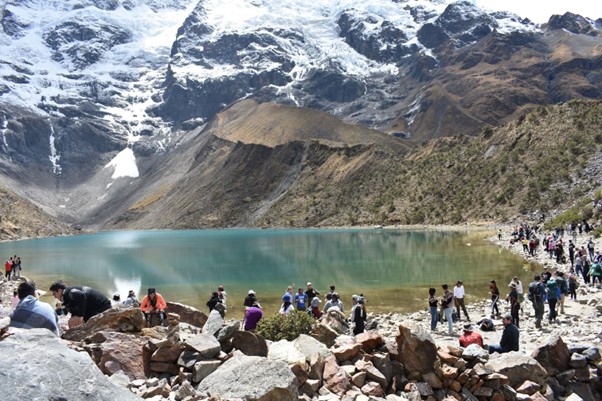
Day 2 of Unguided Salkantay Trek: Soraypampa-Chaullay
Rise early at Soraypampa to start your trek up the pass to Abra Salkantay. If you get going just after 6, you should be ahead of most tour groups. The trail up the pass is easy to follow.
It should take 2-3 hours to get to the top. This is a good spot for a snack break and for taking some beautiful photos. From Salkantay Mountain, you will descend about 1-1.5hrs to the village of Wayramachay.
On the left of the trail, glacial streams flow off the mountain. This is a good spot to refill your water bottles. I’d still recommend using a filter to play it safe though.
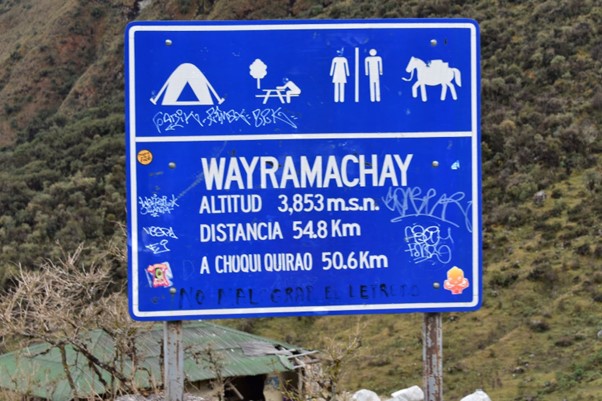
Wayramachay is the first village you pass in the catchment below Mount Salkantay.
Wayramchay is a small, rural settlement below Mount Salkantay. You should arrive here around lunchtime. There are a few small restaurants where you can stop for something to eat (expect to pay 10-15 soles).
From Wayramchay, the surrounding landscape changes to a mixed tropical forest. Temperatures increase significantly and there are biting insects (so, remember to carry bug spray!).
The path is very easy to follow. It is a fairly gentle descent on a dirt track all the way down to Chaulley. Be sure to move out the way for horses and mules coming up the path simultaneously.
Chaullay (2,860m / 9,383ft) has a good variety of backpacker accommodations. Most of these camps have restaurants and small shops selling snacks and beer.
You will have no problem finding food and accommodation for the night. Budget around 30-40soles ($8-$10) for a room for two people. You can also find electricity here to charge your phone.
Day 3 of Unguided Salkantay Trek: Chaullay-Lucmabamba / Santa Theresa
From Chaullay, you will walk a short distance along the road and through another town called Collpapampa.
If you are trekking unsupported, you may get a little confused on the trail out of Collpapampa. There are many subsidiary trails that lead off the road. Generally, these are shortcuts that lead the same way down into the valley. It’s best to follow the road or an organized tour group.
Just before the road crosses the river, you will see the trail veer off to the left bank. There is a green safety railing, making it easier to spot. In case your powers of navigation fail you, it’s a good idea to follow this single-track trail. You can walk along the road, but it will make your route a lot less interesting.
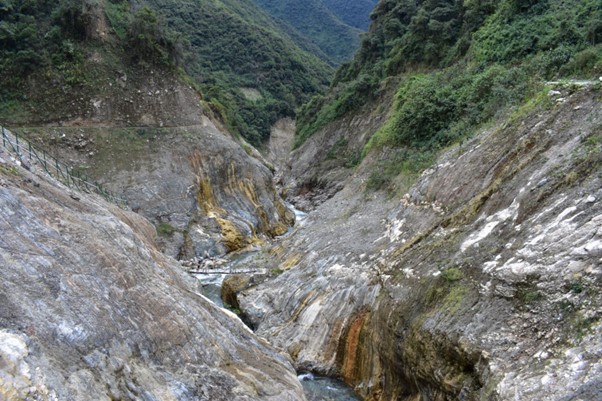
A view of the river when you descend from Collpapampa. From here, hikers are able to see the trail on the left.
When you follow this trail, the path soon reaches a steep section through the forest. When you get to the fork at the top, KEEP RIGHT. You will gradually get back to following the river course.
The trail takes you past a waterfall which is another good spot to refill your water bottles. From there, you will pass by Maracuya plantations and rest areas selling fresh juice.
As you approach La Playa, the trail splits. If you stay on the left bank of the river, which most tour operators do, you will cross a bridge. From here, the trail takes you straight into La Playa Lucmabamba (2,008m / 6,587ft above sea level).
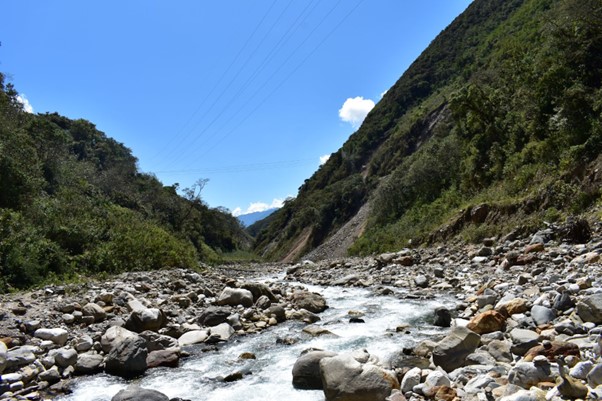
Crossing the river to the road up the right bank.
You can also cross to the right along the riverbank and across a small suspension bridge. From here, the trail goes back up to the road. Follow the road to La Playa. If you are tired, you could try to catch a ride to town with a van from here.
You can find accommodation in La Playa, but it is nicer to walk a few extra kilometers to Lucmabamba or Santa Theresa. These quieter sites have good camps and accommodations on coffee plantations.
Please Note: It is worth stopping in La Playa to do a short coffee tour. There is one particular cafe with a machine for serving cappuccinos. Look out for a double-story, wooden restaurant with ‘Coffee’ signs. It is almost the first structure on the left as you enter the town.
Day 4 of Unguided Salkantay Trek: Santa Theresa / Lucmabamba- Llactapata-Hydroelectrica-Aguas Calientes
On the fourth day, you will go up the mountainside through the coffee plantations. There are signs off the road to the trail. I recommend asking the accommodation owners or locals to point you in the right direction so you don’t get lost.
Some of this trail is on the original, stone Incan stairway. Once you are on the path, it zig-zags upwards and you can’t really go wrong. It takes around two hours at a good pace to reach the top.
When the trail flattens out in the bamboo forest, you will see some more signboards. From here, the trail splits again. To the left is a shortcut to Hydroelectrica and views of Machu Picchu. I recommend walking for about 3 minutes and spending some time at this viewpoint. The first sight of Machu Picchu in the distance is pretty good motivation.
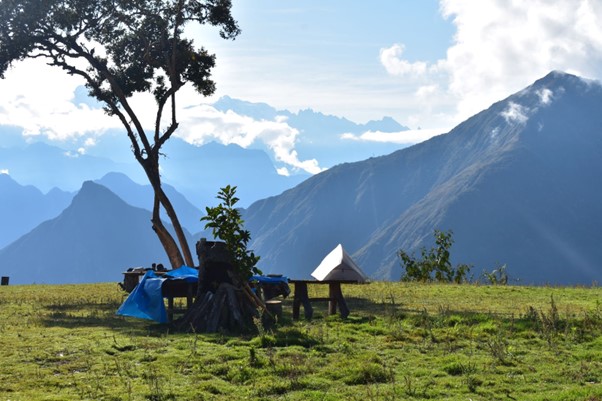
Viewpoint of Hidroelectrica and Machu Picchu. If you are trekking with a tent, you can also camp at this amazing spot.
There is also a shop selling sandwiches, juice, and coffee at this lookout. It is worth holding out until here for a late breakfast.
After spending some time enjoying the view, backtrack onto the main path and take the right fork. It is a short walk down to Llactapata ruins. After the ruins, there is around 1.5-2 hours of a steep trek downhill to the river valley.
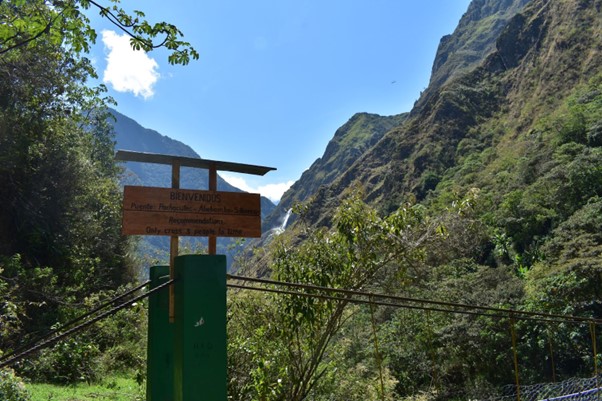
Bridge to Hidroelectrica
Cross the bridge and follow the road to Hidroelectrica. There is a checkpoint here where you will need to present your passport. You can either have lunch in Hidroelectrica or continue to Aguas Calientes.
It is possible to buy a train ticket to Aguas Calientes, which costs about $30. You can book your ticket on the Peru Rail website or take a chance and buy it at the station when you arrive.
Alternatively, the 10km / 6 mile walk to Aguas Calientes is completely flat and quite pretty. In Aguas Calientes, you will have a whole range of hotels and backpacker accommodations to choose from.
Aguas Calientes' accommodation can be booked in advance, which I highly recommend doing. After around 22km / 13,7mi of hiking, you are not going to feel like searching for a hostel.
Day 5 of Unguided Salkantay Trek: Aguas Calientes-Machu Picchu-Cusco
From Aguas Calientes (Machu Picchu town), you either need to catch a bus (which costs about $12 each way) or walk up the 1700+ stairs. I found the stairs to be a fitting way to reach the citadel after the 4-day trek.
It is most important that you book your Machu Picchu ticket well before arriving in Aguas Calientes. Tickets sell out up to two months in advance for the busy season (June - August).
Personally, I like buying the early tickets (6 AM). This allows you to explore the ruins before they become too crowded with other tourists later in the afternoon.
You can acquire the services of a registered guide outside the gate. Expect to pay 40-50 Soles per person for two or more people, or 80-100 Soles if you are doing a solo Salkantay trek. You can also do some reading in advance or take a good guidebook (here are some great recommendations) on your travels.
Don’t walk around uninformed. Your experience will be immeasurably heightened if you have good information to draw on as you walk through the city.
For DIY trekkers, it is possible to trek back to the Hidroelectrica Station. Here, you can get a bus that will take you all the way back to Cusco, via Santa Theresa and Ollantaytambo. This is a longer, but cheaper route than taking the train.

Get a Machu Picchu trek quote
Start planning your Machu Picchu hiking holiday.
Conclusion
If you would like more information on the solo Salkantay Trek, you can read our full Salkantay Trek Guide. This complete guide includes information on elevations, the best time to hike and more.
We also have some helpful information on altitude sickness and how to deal with it in this article.
Feel free to ask questions in the comment section below and we will get back to you within 24 hours.

Hi
My husband and I are looking to hike the Salkantay November 8-11 2025. Can you recommend what circuit ticket to purchase from the Ministry of Culture online? There are 3 options. https://www.machupicchu.gob.pe/circuitos-y-rutas-de-visita/
thanks
Hi Caitlin, I’d recommend circuit 2 for the best overall experience. It covers all major highlights, including the Guardhouse (classic postcard view), Main Plaza, Sacred Rock, Temple of the Sun, and Intihuatana (Sun Stone), and is ideal for first-timers who want the full Machu Picchu experience.
Hi, thanks for this informative post. I am considering doing this with my 11 year old. Where possible we would add more days to give shorter walks and more rest time. Are there any accommodations in mid points of your days? Thanks in advance. E
Glad you found this helpful! You could potentially camp or stay over at the village of Wayramachay after the Salkantay Pass on Day 2, that would make the day a bit shorter. I also found Day 4 to be very long, with kids I’d suggest booking a train ticket from Hydroelectrica to Aguas Calientes so you don’t have to walk that section.
I'm wondering if there's any way to cut this trek to 3 days as a solo? I know expedition companies do it but I can't figure out if we can take a taxi between La Playa and Hidroelectrica as a solo traveler
Jon Speirs
Hi Jon, I’m not 100% sure but I suspect it is possible. You will probably have to arrange the taxi/shuttle from Cusco before you depart on your hike.
Excellent blog, thanks for the information. I am curious if you know if it's possible to hire a taxi from La Playa to Hydroelectrica, to turn it into a 3 day trek. I know private companies offer that version, but wonder if it's possible to do solo. Thanks so much!
Very helpful article. I wonder if you could give advice on these two questions –
What acclimatization time would you suggest before this trek? (We are planning for two full days in Cusco prior to.)
Is there any issue with food safety / hygiene with food purchased along the trail? Presumably eat only cooked food (no raw vegetables)… Can you trust that water for cooking/food prep is all boiled/filtered? (Seems like the trail is quite safe as you describe it, getting sick from food could be biggest risk?)
Hi Jeff, glad this is helpful. 2 days (48hrs) is usually the recommended time to acclimatize. You will feel the altitude for sure on the pass ascent so just take that slow and drink lots of water (small sips often).
I didn’t have any issues with food on the trail but it always helps to play it safe and wash any fruit. Also pack some sort of rehydrate and meds for stomach issues just in case. I suggest taking a bottle with a filter for double security but boiling the water is generally good enough.
Thank you! A very informative guide! I am planning my trip to Machu Pichu now, your post is very beneficial.
Hey Alison,
I am planning on doing the Salkantay Trek with my girlfriend in December, any tips for that time of year, and there is no need for a sleeping bag/tent?
We can stroll into a town every evening and find lodging?
Thank you for this, your post is so helpful
Hi Mendel, so glad that you found this helpful! December is low season in the region. It’s also rainy season so it’s best to accept that if you are going over this time, you will probably get wet! The weather is unpredictable so you may get lucky and have some or all clear days but I’d say this is the exception. Bring good waterproofs and a waterproof backpack cover.
Less people are trekking this time of year which is a bonus if you prefer quieter trails and can tough out the rain and mud. I’m not sure if this also means less of the accommodation places will be open or that you will have more choices. Some huts are owned by operators and may be locked up if there aren’t trips running. My advise is always to look up places before you go and reach out, it will give you some peace of mind. Hope that helps!
Thank your article, it was very, very helpful. Me and a spanish speaking friend will be walking Salkantay trail mid May this year. I do not plan to carry a tent, and will hopefully be able to find a place to sleep each night, (or perhaps book on booking.com that day or a day before? One question I do have, is if I'm doing it without a tent, and planning on staying in places along the way, should I still bring a quilt or sleeping bag? I do not see this addressed anywhere. And any idea how cold the evenings get mid May on the trail?
Thank you very much
Michelle
Hi Michelle, great to hear that you are planning on doing this trek! I think it’s a great idea to try book the nights you can before you go. Yes, I’d recommend taking a sleeping bag with. It’s better to be prepared, especially for more basic accommodations.
Thank you for your post. Very informative. I have a question about the accommodation. I don’t want to carry a tent but will I still need to carry a sleeping bag?
Hi Christian, yes, I’d strongly recommend bringing a sleeping bag. Some of the accommodations may have bedding but you will have more options if you are prepared to stay in places that only offer a mattress. Hope that helps!
Hello Alison!
I want to say you thanks a lot for your detail description of Salkantay trek.We have never been in South America but this part of earth time to time reminds us about itself
Hopefully we will make it next year!
wish you all the best in your traveling!
Hi Olga. Fantastic to hear! It’s a beautiful part of the world, I hope you get to experience it!
Hi Alison! If you wouldn't mind, I just have one question:
Where did you store your hiking gear while you were in Machu Picchu? I'm specifically asking because I'm taking expensive camera equipment (including a gimbal – which is basically a fancy selfie stick and those are not allowed) and I don't want to leave it in the bag check bc I don't want my things getting stolen. Do you know how safe the luggage storage is? Is it lockers where I get a key or a passcode and only I can get in? Are there cameras? If the luggage storage at Machu Picchu is not fully secure, is there a more secure place to leave my things?
Hi Paula. I left my main bag at the accommodation where I was staying it in Aguas Calientes. Most of those accommodations have a lock up room / safe which I felt secure leaving things in. Unfortunately I’m not sure about the storage at Machu Picchu itself as I only took a small backpack up and could bring it in. Generally I think it would be fine there but yeah, if you are worried best to leave it locked-up at your accommodation in town. Hope that’s a little helpful:)
Hi, is it possible to hike the trail in February?
Hi Annalena, yes, it is possible to hike the Salkantay in February. Only the Inca trail closes in February. I wouldn’t recommend hiking in this month though as it gets pretty wet and visibility isn’t great. There is also landslide risk during the wet season so I recommend taking a guide.
Thank you for this informative post, Alison!
I have a question about Llactapappa. In your post it seems that only "unofficial camping" is available, but there seems to be a lodge there. At least that is what their website indicates. (https://llactapatalodge.com/llactapata-lodge.html)
Am I mistaken?
My family will be walking this unguided in December and we were considering staying in Lucmabamba (or Santa Teresa) one night, and then having a short day to Llactapappa for the next night.
We are planning to end the trek in Hidroelectrica because we will have already spent two full days at Machu Picchu prior to this trek. Would we be missing much by skipping the walk to Aguas Calientes?
Thanks!!
Hi Erik, glad you found this post useful!
Yes, that lodge is just below the ruin site. We made a brief rest stop there and it does have a great view of the valley.
If you have already visited Machu Picchu, I wouldn’t worry about skipping the trek to Aguas Calientes. It is all along the railway with a lot of other hikers doing the same thing. Not really a highlight of the route.
Hope that helps!
If I understood it correctly you decided to walk the stairs the last part from Agua Calientes to Machu Picchu. Also, I understood it as you bought the 6AM ticket. When does that mean that you started the last hike up to Machu Picchu?
I also have the 6AM ticket and thinking about if I should take a bus or hike the last bit.
Hi Andre, yes that’s right. After hiking for 4 days it seemed like cheating to catch the bu! I was pretty exhausted at that time plus you need to start early (just after 5 am) to get up in time. You walk out of town, past the bus stop and a permit check point and then start to climb the 1700 (or so) stairs. There are usually others doing te same thing so it shouldn’t be hard to follow the crowd or ask directions beforehand. It was dark for most of the way but pretty tough. Still, felt rewarding to reach the site on foot. Hope that helps!
big greetings 🙋🏼♀️in January I am planning a solo sankatrai trek. how far in advance do I have to buy a ticket to enter Machu Picchu. thanks
Hi Marija, depending on the season I recommend getting your permit for Machu Picchu as early as possible. At least a few weeks before you travel.
Just wanted to say thank you for posting something so helpful. Really cleared my concerns when if comes to finding accommodations.
Hi Christopher, glad this helps you out
Thank you a lot from this post! I downloaded it to my phone and used it as a ”map” in the salcantay trek. I had zero problems doing the trek alone and I met a lot of others who were doing it alone aswell. The prices have went a bit up since your post but I managed to spend around 140€ in total in 5 days. I’m truly thankful that you made this post so clear and easy to follow!
Hi Toni
That’s great to hear, thanks for that feedback regarding the prices. I’ll update the post when I get a chance.
Thank you so much for this informative guide! I live in the Sacred Valley and am planning a Salcantay trek in Aug/Sep this year. This post is so detailed, I feel so much more at ease about doing this trek solo. Love the tips about food and accommodation too. Thanks again!
You are most welcome Ellie, Enjoy it!
Hello, thank you for this post, the information is very helpful as my wife and I are thinking of doing this trek in a few weeks.
I have some questions though…
1 – Is it possible to get an arrieros at Challancancha?
2 – Would we need to get different arrieros along the way or would one go the whole distance? If just one, would we need to provide food/accommodation and is that included in the cost?
3 – Can you tell us which village campsites provide tents? For instance Wayramachay? As we may split day 2 and other long days up.
Hi Tom
Great to hear!
I’m not 100% sure about the arrieros (muleteers) as I didn’t try to hire a mule. It seems most of them work with trekking companies and solo hikers tend to carry their own gear. You could approach one of the trekking companies and ask if its possible to only hire a mule/ horse (to be honest, I doubt they would be helpful).
1. I didn’t see any ‘freelance’ arrieros hanging around Challancancha.
2. I only saw mules on the trail on the first and second day. There was an option to ride a horse/ mule up the steepest pass to Salkantay mountain. I’m sure you could pay for your bags to be taken up (note that the animals don’t go all the way to the top). From Salkantay pass, it’s all downhill to the second camp/ hostel. Companies use vehicles to transport luggage from this point. With a little negotiation, you may be able to find a driver with a group and get your bag dropped at Santa Teresa or Hydrolelectrica. Just be sure you are clear on where you can meet/ pick up later (and what you are paying).
3. I saw campsites at Wayramachay but there didn’t seem to be tents available. Its an easy (if long) downhill to Chaullay where there’s a few more accommodation options. Day 4 was the toughest for me, unfortunately, it would be difficult to split unless you carry a tent and camp at the top (an ‘unofficial’ site above the Llactapata ruins).
I hope this helps!
Thanks so much for your quick response Alison!
This may make it a bit too tricky for us unfortunately but we'll see if we can find a work around or two.
Hi!
I'm wondering which circuit of Macchu Picchu you did? I'm reading good things about hiking Macchu Picchu mountain, but I just think I won't feel like it after doing the whole Salkantay trail.
FYI: this post was so useful, thank you!
Thanks!
Juliette
Hi Juliette
Glad to hear you found this helpful! I did circuit 4 with Huchuy Picchu (a very small peak that is relatively newly opened). This is a pretty standard circuit but, like you, I figured I wouldn’t be up for another climb and I wasn’t too phased about the ‘classic’ photo spot or Inca Bridge. Honestly, I was perfectly happy with my choice. It’s only about 10 minutes up Huchuy Picchu and we had a pretty amazing view of Huayna Picchu. The circuit you choose depends what your priorities are to see on the site.
Enjoy!
Thanks for this great Blog.
I'm just wondering which year you did it.
And if I hike the whole trail alone and will not be able to share the accommodations with a second person, do you think I will not pay more than 200$?
Hi Sena, I did this hike in 2022.
I think it is still completely possible to do it alone for under $200 so long as you are prepared to hunt around a bit more for cheap accommodation options. This will be much easier if you can ask around in a little Spanish.
There are a few campsites but honestly, I’d pay a little more not to carry a tent. Take at least some of your own food and definitely a water filter as prices are heavily inflated on the trail. My best advice would be to get onto a Peru Facebook travel group (I was on Backpackers Peru) and find someone who has a similar plan to you.
Enjoy It!
Hi there, thank you for the detailed explanation!
A few questions:
How common is it to find a place to feel in water?
do you have a map where it's possible to see the trail with day distribution?
How much Km it's for each day?
Is there a good signal for the phone in case of emergency?
Thanks a lot!
Hi Arik, glad you found it helpful!
You can full day-by-day in this article. There is a also a nice map. Basically Day 1= 12km, Day 2=22km, Day 3=18km, Day 4= 17km. Day 5 depends if you walk the 2km up to Machu Picchu or take a bus.
As far as water goes. It’s best to take a bottle with a filter. On the first day, there was no real place to fill up but the walk is very short. There are a few spots to refill on all the other days.
I honestly didn’t check my phone too often but I did notice there was signal on some of the trail as well as around most camps. It’s not completely isolated and there are a lot of other people on the trail which makes it feel safer.
Hope that answers your questions
Alison,
A question I have; when catching the collectivo out of Cusco to go to Mollepata, where do I find that bus station at in Cusco?
thanks- Renae
Hi Renae, I think you can take a collectivo to Curahuasi (marked like this on Google Maps) and ask to climb off at Mollepata. I think there are also big buses to Curahuasi. You may need to climb off at Limatambo and then take a collectivo to Mollepata.
Thanks so much, Mark!
Another question about the collectivo to Mollepata, approx how many soles is the going rate for that?
Thanks! Renae
Hi, thanks for the ultimate guide about solo trek Salkantay. It is very useful!
I have a question. Is there a tax for entry the Salkantay and it is included in that count:
"It is possible to do a solo Salkantay Trek for around $175-$200 per person. This price includes food, accommodation, basic transport and Machu Picchu entrance tickets."
Greetings, Rebecca
Hi Rebecca, there is no tax that I’m aware of, but you will need to purchase tickets for Machu Picchu.